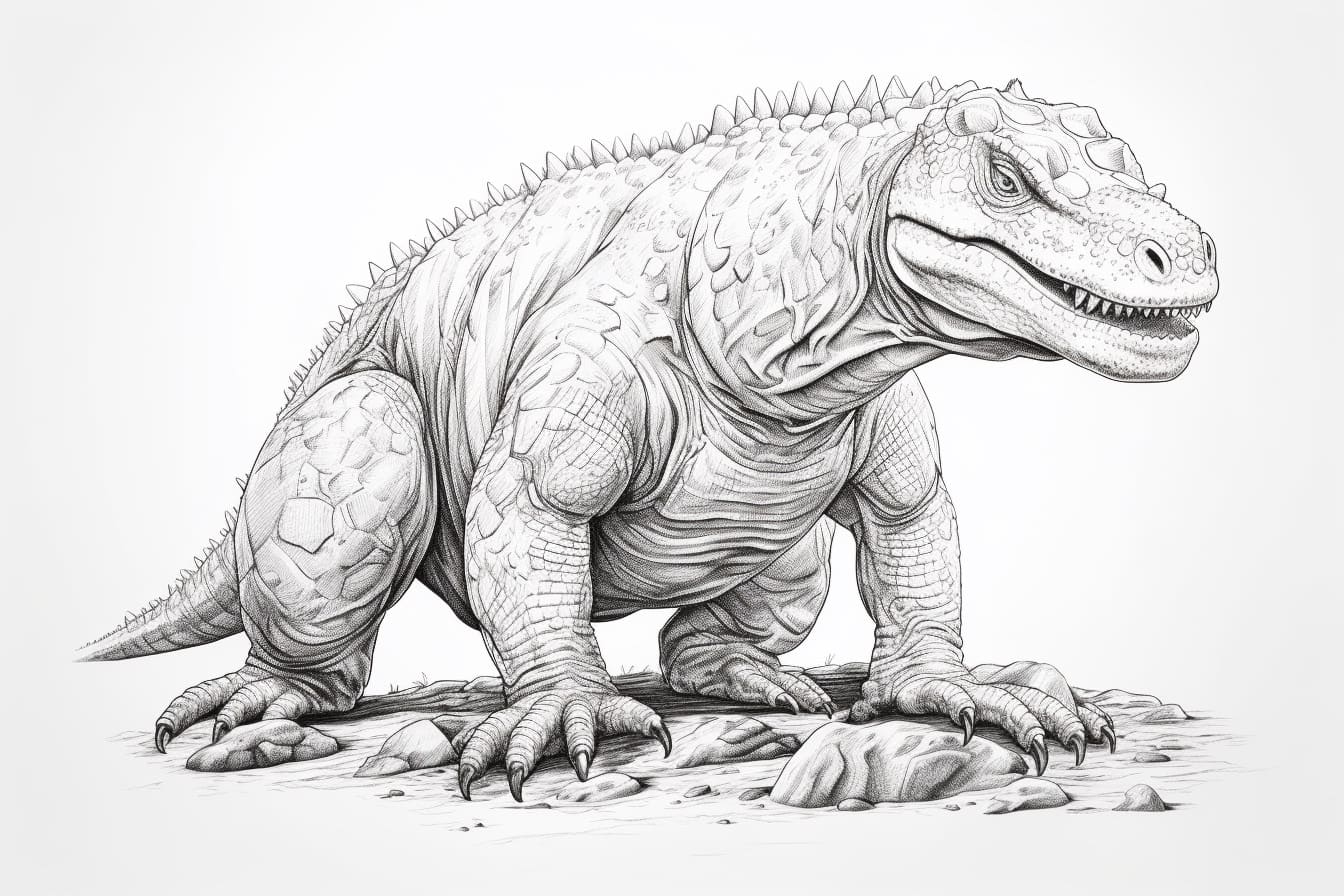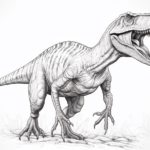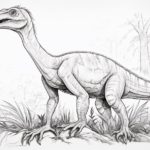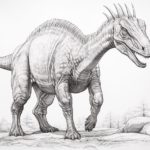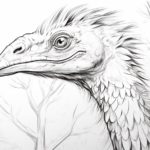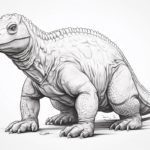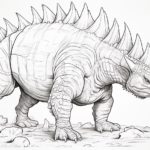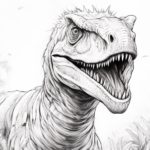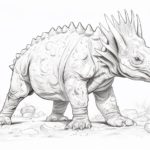Sauropelta, with its distinctive armor plating and impressive size, is a fascinating subject for artists and dinosaur enthusiasts alike. This herbivorous dinosaur roamed the Earth during the Late Cretaceous period, and its well-preserved fossils have provided valuable insights into its anatomy and behavior. In this tutorial, we will explore how to capture the unique features of Sauropelta in a detailed drawing, from its massive body to its intricate armor plates. So grab your pencils and paper, and let’s bring this ancient creature to life on the page!
Materials Required
To draw a Sauropelta, a type of armored dinosaur, you will need the following materials:
- Paper: Choose a sturdy paper that can withstand the pressure of drawing and erasing.
- Pencils: A set of drawing pencils ranging from 2H to 6B for sketching and shading.
- Eraser: A good quality eraser for correcting mistakes and refining details.
- Drawing Pen: A fine-tip drawing pen for outlining and adding details.
- Colored Pencils or Markers: Optional for adding color to your drawing.
- Reference Images: Gather reference images of Sauropelta from books or online sources to guide your drawing.
With these materials, you can create a detailed and accurate
How to Draw a Sauropelta: a Step-by-step Guide
Step 1: Gather Your Materials
Gather all necessary materials for drawing, including paper, pencils (preferably a range of graphite pencils for shading), eraser, and a reference image of a Sauropelta.
Step 2: Start with Basic Shapes
Begin by lightly sketching the basic shapes of the Sauropelta using simple geometric forms. Start with an oval for the body, circles for the head and joints, and straight lines for the limbs.
Step 3: Refine the Outline
Using the basic shapes as a guide, start refining the outline of the Sauropelta. Pay attention to the proportions and shape of each body part, including the head, neck, torso, limbs, and tail.
Step 4: Add Details
Add the distinctive features of the Sauropelta, such as the armor plates along its back, the spikes on its shoulders, and the texture of its skin. Take your time to carefully observe the reference image to capture these details accurately.
Step 5: Shade and Add Depth
Start shading the Sauropelta to add depth and dimension to your drawing. Use a range of graphite pencils to create light and shadow, paying attention to the direction of light in your reference image. Shade darker areas such as under the body and limbs, and leave lighter areas where light hits the dinosaur.
Step 6: Refine the Details
Once you have shaded the basic shapes, go back and refine the details of the Sauropelta. Add texture to the armor plates, define the spikes more clearly, and enhance any other features that need more definition.
Step 7: Final Touches
Review your drawing and make any final adjustments as needed. Erase any stray lines, refine the shading, and add any additional details to make your Sauropelta drawing more realistic and polished.
Step 8: Sign and Date
Finally, sign and date your artwork to mark its completion. Admire your finished drawing of a Sauropelta and consider sharing it with others to showcase your artistic skills.
Conclusion
In conclusion, drawing a Sauropelta requires attention to detail, patience, and a deep understanding of its anatomy. By following the step-by-step instructions and practicing consistently, anyone can master the art of drawing this fascinating dinosaur. Remember to pay close attention to the proportions, textures, and overall composition to bring your Sauropelta drawing to life. Keep practicing, experimenting, and refining your skills to create stunning and realistic illustrations of this prehistoric creature.
Fun Facts About Sauropeltas
- Sauropelta was a type of armored dinosaur known as an ankylosaur, meaning “fused lizard,” due to its thick, bony armor plates covering its body.
- This dinosaur lived during the Late Cretaceous period, around 112 to 105 million years ago, in what is now North America.
- Sauropelta had a unique body structure with a low-slung, heavily armored back and a tail equipped with a bony club that it could use for defense against predators.
- Despite its formidable appearance, Sauropelta was a herbivore, feeding on plants and vegetation with its leaf-shaped teeth.
- Fossil evidence suggests that Sauropelta may have lived in herds, which could have provided protection against larger predators.
- The name Sauropelta means “lizard shield,” highlighting the dinosaur’s armored nature and defensive capabilities.
- Sauropelta is one of the best-preserved ankylosaur fossils ever discovered, with several nearly complete skeletons found in the United States.
- Studies of Sauropelta fossils have provided valuable insights into the evolution and behavior of armored dinosaurs, helping scientists better understand the diversity of life in the prehistoric world.
- Sauropelta’s armor plates were not only for protection but also played a role in regulating body temperature, similar to the function of modern-day reptiles’ scales.
- The discovery of Sauropelta has contributed to our understanding of the complex ecosystems that existed during the Late Cretaceous period, showcasing the diverse range of dinosaurs that roamed the Earth millions of years ago.
Suggestions for Scenes and Settings for Sauropelta Drawings
Absolutely! Sauropelta was a type of armored dinosaur from the Late Cretaceous period, known for its distinctive rows of bony plates along its back. Here are some specific scene and setting suggestions to inspire your drawings of Sauropelta:
- Jurassic Forest Clearing: Place Sauropelta in a lush, dense forest clearing surrounded by ancient ferns and towering trees. The dappled sunlight filtering through the canopy creates a dramatic play of light and shadow on its armored plates.
- Riverbank Encounter: Show Sauropelta wading in a shallow river, its reflection rippling on the water’s surface. Birds might be perched on its back, picking off insects attracted to the dinosaur’s presence.
- Volcanic Landscape: Place Sauropelta in a prehistoric volcanic landscape, with smoke rising from distant volcanoes and rivers of molten lava flowing in the background. The harsh environment contrasts with the dinosaur’s sturdy armor.
- Dusk in the Desert: Set Sauropelta in a desert scene at dusk, with the last rays of the setting sun casting an orange glow over the sand dunes. The dinosaur’s silhouette stands out against the colorful sky.
- Mountain Plateau: Picture Sauropelta grazing on a high mountain plateau, with snow-capped peaks in the distance. The thin air and rocky terrain challenge the dinosaur’s movements, showcasing its adaptability.
- Swampy Marsh: Show Sauropelta navigating through a murky, swampy marshland, its armored plates gleaming in the dim light. Strange prehistoric creatures lurk in the waters around it.
- Cliffside Nesting Site: Imagine Sauropelta nesting on a cliffside overlooking a vast prehistoric landscape. Adults tend to their young while pterosaurs soar overhead in search of food.
- Underwater Ruins: Place Sauropelta in an underwater scene, exploring ancient ruins submerged in a shallow sea. Moss-covered columns and broken statues create an eerie backdrop for the armored dinosaur.
- Moonlit Oasis: Set Sauropelta in an oasis under the light of a full moon, surrounded by lush vegetation and a tranquil pond. The peaceful scene highlights the dinosaur’s role as a gentle giant.
- Alien Landscape: Let your imagination run wild by placing Sauropelta in a fantastical, alien landscape with bizarre rock formations, glowing flora, and strange creatures. The otherworldly setting

